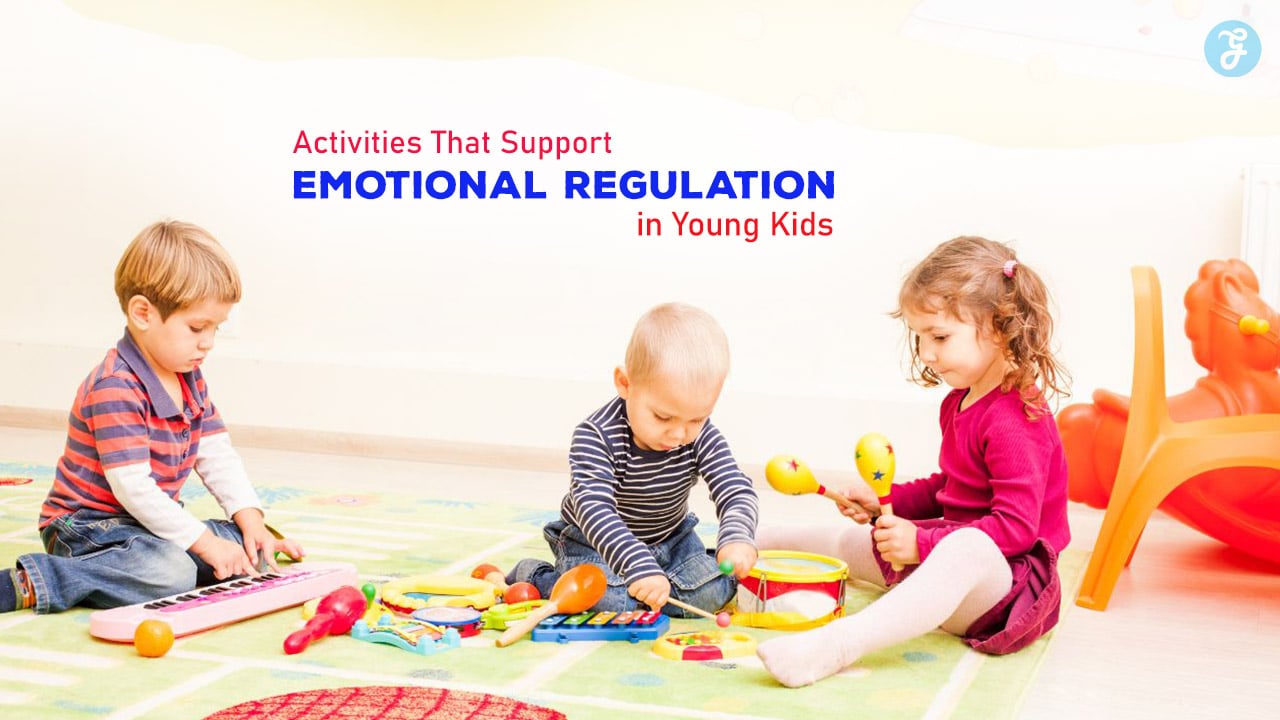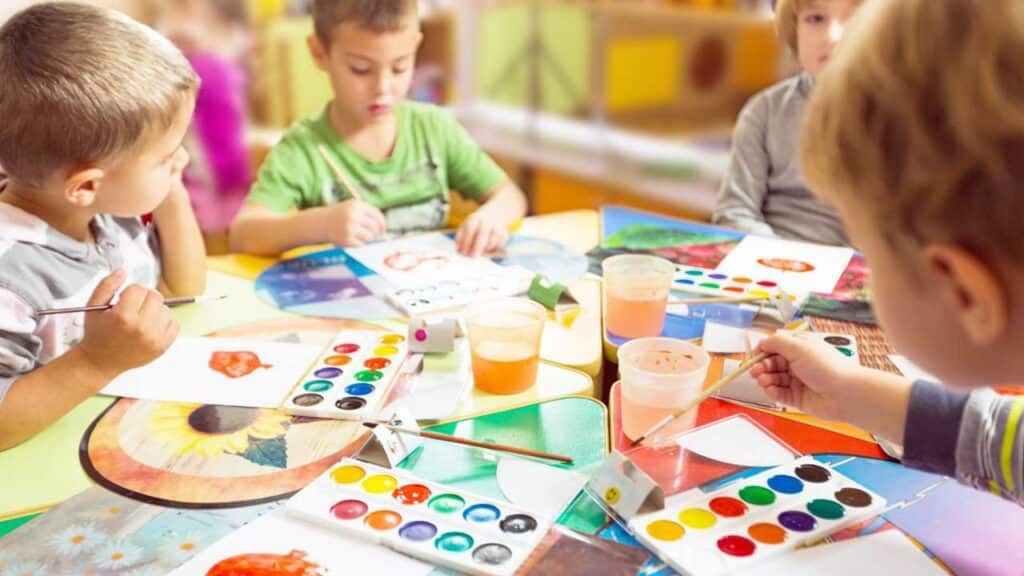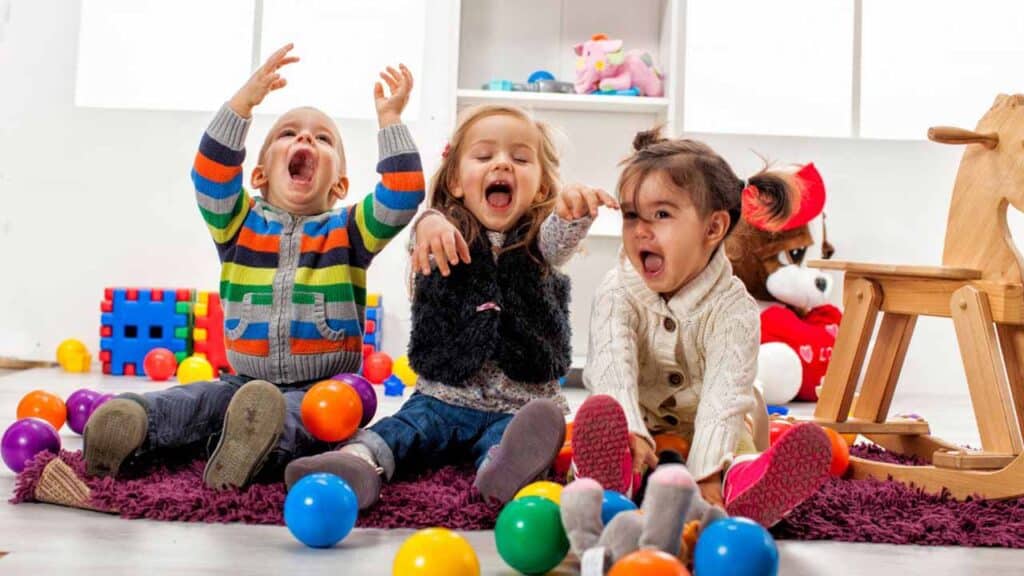Emotional regulation is a vital skill for young children to develop, as it helps them navigate the ups and downs of daily life.
Children who learn to manage their emotions can better cope with frustration, anger, anxiety, and disappointment, leading to healthier social interactions and improved learning outcomes.
However, young children are still learning how to process complex feelings, making it essential for parents and caregivers to offer engaging and practical tools for emotional regulation.
Below are 12 detailed activities that can help young kids develop their ability to self-regulate emotions in a fun and supportive way.
1. Deep Breathing Exercises
Deep breathing exercises are a foundational technique in emotional regulation and help children calm down during moments of heightened emotion.
Key Benefits:
- Calms the Nervous System: Deep, slow breaths activate the parasympathetic nervous system, reducing the body’s stress response and bringing a sense of calm.
- Improves Focus and Attention: By focusing on their breath, children can shift attention away from distressing thoughts or feelings and ground themselves in the present moment.
- Easy to Learn and Practice Anywhere: Deep breathing techniques are simple, portable, and can be practiced anytime—whether at home, school, or in public.
Activity Example:
Introduce your child to “belly breathing,” where they place one hand on their stomach and the other on their chest.
Ask them to inhale deeply through the nose, expanding their belly like a balloon, and then slowly exhale through the mouth, imagining they are blowing bubbles.
Repeat for several breaths, encouraging them to notice the rise and fall of their belly.
This helps them focus on the act of breathing, gradually calming their nervous system.
Expand on this by making it fun with visuals: Use a feather or a pinwheel to demonstrate breathing.
Ask them to blow the feather into the air or make the pinwheel spin slowly, teaching them to control the pace of their breath while observing its effects.
2. Mindful Coloring
Mindful coloring is a relaxing, creative activity that encourages children to focus on the present moment and helps reduce emotional distress.
Key Benefits:
- Encourages Relaxation and Calm: The repetitive and rhythmic motion of coloring provides a soothing effect, helping children release stress and anxiety.
- Increases Focus and Mindfulness: Coloring requires concentration on the task at hand, diverting the child’s attention from overwhelming emotions to something more structured and calm.
- Fosters Creativity and Emotional Expression: Coloring can also serve as a creative outlet for emotional expression, allowing children to process their feelings through colors and artistic choices.
Activity Example:
Provide a variety of mandalas or simple patterns for your child to color.
Explain that this activity is about taking their time and enjoying the process, not rushing.
Encourage them to select colors that match how they are feeling.
For example, ask, “What color do you feel like today?” This helps them associate colors with emotions, facilitating emotional awareness.
Enhance the activity by playing soft, calming music in the background.
The combination of mindful coloring and soothing sounds can deepen the relaxation effect, making it an effective tool for emotional regulation.
3. Sensory Play
Sensory play involves hands-on activities that engage a child’s senses, such as touch, smell, sight, and sound, helping them regulate emotions through sensory exploration.
Key Benefits:
- Promotes Calm and Focus: Engaging in sensory play can help children calm their emotions by giving them something tactile and repetitive to focus on.
- Provides a Soothing Experience: Different textures, such as water, sand, or slime, provide a soothing and grounding experience for children, which can help them feel more in control of their emotions.
- Encourages Exploration and Emotional Expression: Sensory play offers a safe and controlled way for children to express their emotions physically without needing to articulate them.
Activity Example:
Set up a sensory bin with different materials like rice, sand, kinetic sand, or water beads.
Encourage your child to explore by scooping, pouring, and feeling the different textures.
Sensory play can also include nature-based materials like leaves, small stones, or shells, which can provide both a tactile and visual experience.
For an additional emotional regulation tool, combine sensory play with mindfulness.
Ask your child to describe what they are feeling: “How does the sand feel between your fingers?” or “What sound does the rice make when you pour it?” This helps them focus on the sensory experience rather than their emotional distress.
4. Emotions Chart
An emotions chart is a simple yet powerful tool that helps children recognize and name their emotions, an essential step in developing emotional regulation.
Key Benefits:
- Increases Emotional Vocabulary: Children learn to identify and label their emotions, which is critical for emotional development and communication.
- Promotes Emotional Awareness: By regularly identifying their emotions on a chart, children become more aware of how they feel throughout the day.
- Encourages Healthy Communication: Once children can name their emotions, they can communicate their feelings more effectively to caregivers, reducing frustration and misunderstandings.
Activity Example:
Create an emotions chart featuring simple images or faces that represent a range of emotions like happy, sad, angry, scared, and excited.
When your child is experiencing a strong emotion, ask them to identify which face matches how they feel.
Afterward, talk with them about why they might be feeling that way and what they can do to feel better.
To expand on this, use the emotions chart as part of a daily routine.
For example, ask your child to check in with the chart every morning and evening, noting how they felt during the day.
This ongoing practice helps normalize talking about emotions and gives children the tools they need to navigate their feelings.
5. Yoga for Kids
Yoga combines movement, breath, and mindfulness, making it a great activity for emotional regulation.
For kids, practicing yoga helps them connect their minds and bodies while releasing physical tension.
Key Benefits:
- Promotes Physical and Emotional Awareness: Yoga teaches children how to listen to their bodies and recognize physical signs of stress, such as tight muscles or shallow breathing.
- Relieves Stress and Anxiety: Certain yoga poses, such as child’s pose or forward folds, are designed to calm the nervous system and reduce stress.
- Encourages Focus and Self-Control: Yoga requires concentration and control, helping children learn to focus their energy and manage their emotions.
Activity Example:
Guide your child through simple yoga poses like “tree pose” for balance, “downward dog” for relaxation, and “child’s pose” for calming the body.
Incorporate deep breathing with each pose, encouraging them to breathe slowly as they move from one pose to the next.
Explain how breathing deeply helps them feel more relaxed.
You can also introduce short yoga sessions as part of their bedtime routine, using calming poses to help them wind down before sleep.
This reinforces the idea that yoga is a tool for emotional regulation and self-care.
6. Storytelling with Emotional Themes
Stories offer a wonderful way to teach children about emotions, empathy, and problem-solving.
By relating to characters, children can better understand their own feelings and how to manage them.
Key Benefits:
- Builds Empathy and Understanding: Stories about emotions allow children to see how others experience feelings and develop empathy for different emotional experiences.
- Teaches Emotional Vocabulary and Expression: Storytime is an opportunity to introduce new emotional vocabulary and demonstrate appropriate ways to express feelings.
- Encourages Reflection and Discussion: After hearing a story, children can discuss the characters’ emotions and explore how they might handle similar situations.
Activity Example:
Choose books like “The Color Monster” by Anna Llenas or “In My Heart: A Book of Feelings” by Jo Witek, which focus on emotions and emotional regulation.
Read the story together, and afterward, ask open-ended questions like, “How do you think the character felt when that happened?” or “What could they do to feel better?”
To deepen the impact of this activity, encourage your child to create their own story, where they are the main character learning how to manage emotions like anger or sadness.
This allows them to process their own experiences and think critically about emotional regulation.
7. Creating a Calm-Down Jar
A calm-down jar is a simple, hands-on tool that provides children with a visual way to calm down during moments of emotional intensity.
Key Benefits:
- Visual Soothing: Watching glitter or small objects float to the bottom of the jar is mesmerizing, helping children shift their focus from their feelings to the calming visuals.
- Promotes Mindfulness and Patience: The process of waiting for the glitter to settle teaches children to pause and reflect before reacting to their emotions.
- Portable Tool for Emotional Regulation: A calm-down jar can be used anywhere—at home, in school, or even during travel—as a quick and accessible way to de-escalate strong emotions.
Activity Example:
Create a calm-down jar with your child by filling a small jar with water, glitter glue, and fine glitter.
Let your child shake the jar when they feel upset, then watch the glitter swirl and slowly settle to the bottom. Encourage them to take deep breaths as they observe the glitter fall.
To enhance the experience, ask your child to focus on a calming thought or feeling as the glitter settles, like imagining a peaceful place or thinking about something that makes them happy.
This combination of visual and emotional soothing can be very effective in helping them regulate emotions.
8. Role-Playing Scenarios
Role-playing allows children to practice handling emotions and social situations in a safe, controlled environment, giving them tools for real-life interactions.
Key Benefits:
- Enhances Emotional Understanding: By acting out different emotional scenarios, children learn how various emotions feel and how to respond appropriately.
- Builds Problem-Solving Skills: Role-playing helps children practice handling difficult situations, improving their problem-solving and coping skills.
- Boosts confidence and Emotional Control: By rehearsing emotional regulation strategies, children gain confidence in their ability to manage emotions in real-life situations.
Activity Example:
Role-play various scenarios where your child might feel angry, frustrated, or sad.
For example, act out a situation where their favorite toy is taken away or where they don’t get their way.
Guide them through possible responses, such as using deep breaths, asking for help, or using words to express their feelings instead of acting out.
You can also reverse roles, where you pretend to be the child experiencing a strong emotion, and your child has to help you calm down.
This allows them to see both sides of emotional interactions and practice empathy.
9. Physical Activity
Exercise and physical play are powerful tools for emotional regulation, as they help children release pent-up energy and emotions in a positive way.
Key Benefits:
- Releases Built-Up Tension: Physical activity helps children release tension and frustration, which can build up when they are upset or stressed.
- Improves Mood: Exercise triggers the release of endorphins, the body’s natural “feel-good” hormones, which help improve mood and reduce feelings of anxiety or anger.
- Encourages Focus and Emotional Release: Activities like running, jumping, or dancing allow children to focus their energy on something positive, reducing emotional overwhelm.
Activity Example:
Encourage your child to engage in physical activities like jumping on a trampoline, running around the yard, or dancing to their favorite song when they feel upset or anxious.
Even a short burst of physical activity can help them burn off energy and improve their mood.
For a more structured approach, consider introducing family fitness routines or outdoor games that combine physical activity with fun, like obstacle courses or relay races.
These activities not only promote emotional regulation but also foster healthy family bonding.
10. Progressive Muscle Relaxation
Progressive muscle relaxation involves tensing and relaxing different muscle groups, helping children become aware of and release physical tension associated with stress.
Key Benefits:
- Relieves Physical Stress: Tensing and then releasing muscle groups helps children recognize areas of physical tension and learn how to relax them.
- Promotes Emotional Calm: By systematically relaxing their muscles, children can reduce the physical symptoms of stress and calm their emotions.
- Teaches Mindfulness and Body Awareness: This activity helps children tune into their bodies and recognize how emotions manifest physically, improving overall self-regulation.
Activity Example:
Guide your child through progressive muscle relaxation by asking them to start with their feet. Have them squeeze their toes tightly for a few seconds, then relax.
Move up through the legs, hands, arms, and shoulders, tensing and relaxing each muscle group in turn. Encourage them to notice how their body feels before and after each release.
Pair this activity with slow, deep breathing to enhance its calming effects. This exercise is particularly helpful before bedtime or during moments of high emotional tension.
11. Guided Imagery
Guided imagery is a relaxation technique that encourages children to visualize a peaceful scene, helping them calm down and manage emotions.
Key Benefits:
- Promotes Relaxation and Calm: Imagining a calming scene helps children focus on positive, soothing thoughts, reducing feelings of anxiety or anger.
- Encourages Emotional Control: By visualizing peaceful imagery, children learn to shift their focus away from overwhelming emotions to something calming and comforting.
- Boosts Imagination and Creativity: Guided imagery allows children to use their imagination in a positive way, making it a fun and engaging activity for emotional regulation.
Activity Example:
Ask your child to close their eyes and imagine a place that makes them feel calm and happy, such as a sunny beach or a quiet forest.
Guide them through the experience by asking them to describe what they see, hear, and feel.
Encourage them to picture themselves walking through this peaceful place, breathing slowly and enjoying the experience.
To make the activity more interactive, use calming background music or nature sounds to help them immerse themselves in the visualization.
12. Creating a “Calm Corner”
A “calm corner” is a designated space where children can retreat when they feel overwhelmed, giving them a quiet and safe space to calm down and self-regulate.
Key Benefits:
- Provides a Safe Space for Emotional Regulation: The calm corner is a quiet, distraction-free area where children can go when they feel upset, offering a space for self-soothing.
- Encourages Independence in Emotional Management: By having a dedicated calm space, children can learn to recognize their own emotional needs and take responsibility for calming down on their own.
- Customizable and Personal: The calm corner can be filled with items that comfort and soothe the child, such as soft pillows, sensory toys, or favorite books, making it a personalized space for relaxation.
Activity Example:
Set up a calm corner in your home with a soft blanket, pillows, stuffed animals, and sensory toys like stress balls or fidget spinners.
Include books on emotions or calming coloring books.
When your child feels upset, encourage them to spend time in the calm corner until they feel ready to talk about their emotions or rejoin activities.
To make the calm corner even more effective, involve your child in decorating the space.
Let them choose calming items or colors, which helps them feel more connected to and in control of their calm-down process.
Conclusion
Supporting emotional regulation in young children is essential for their long-term emotional well-being and success.
These 12 activities not only provide effective tools for emotional regulation but also encourage healthy habits that can carry into adulthood.
By integrating fun, engaging strategies like deep breathing, sensory play, yoga, and role-playing into their daily routine, children can build resilience, manage their emotions, and foster better relationships with peers and caregivers.
Whether through creative expression, physical activity, or mindfulness techniques, these activities offer a hands-on approach to helping children navigate the complex world of emotions in a positive and constructive way.




































